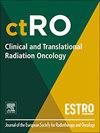青年直肠癌放化疗患者的单中心分析
IF 2.7
3区 医学
Q3 ONCOLOGY
引用次数: 0
摘要
目的//目的:在50岁以下的患者中,直肠癌的发病率增加不成比例。ESMO和NCCN的建议并不是针对特定年龄的,相关文献也很贫乏且相互矛盾。我们决定对过去15年在本中心接受治疗的直肠癌患者进行新辅助放化疗,比较55岁以下和55岁以上两组患者的疗效。材料/方法:788例直肠癌患者被纳入这项单中心回顾性观察性研究(523 = 55岁和265岁)。结果:根据ESMO 2017直肠癌临床实践指南,所有患者被分为不同的风险组。在55岁以下的患者中,88%的患者在诊断时属于不良或晚期风险组,两者的比例相等。在55岁以上的患者中,晚期风险级别明显占主导地位(占总数的62%)。在多因素分析中,OS和DFS随年龄和ESMO危险组的增加而降低。其他变量在多变量中均不显著。对于OS, DFS和MFS,曲线在55岁时明显分离,并且在老年组中存在转移发展的患病率。结论:老年患者存在晚期疾病。年轻的患者似乎在3年和5年有更好的OS。ESMO风险组和年龄是影响OS和DFS的唯一变量。年轻患者在2岁和5岁时的MFS和DFS优于55岁以上的患者。在以氟嘧啶为基础的新辅助化疗中加入奥沙利铂的效果在两组中均不显著。本文章由计算机程序翻译,如有差异,请以英文原文为准。
E_N_T_R_O_P_Y: Monocentric analysis of rectal cancer radio-chemotherapy treatment in patients of young age
Purpose//objectives
A disproportionate incidence‘s increase of rectal cancer in patients younger than 50 years of age. The ESMO and NCCN recommendations are not age-specific and the literature is poor and conflicting. We decided to examine patients with rectal cancer treated in our centre in the last 15 years with curative neoadjuvant radiochemotherapy comparing outcomes in the two groups under and over 55 years old.
Materials/methods
788 rectal cancer patients were enrolled in this monocentric retrospective observational study (523 =>55 years and 265 < 55). All patients received neoadjuvant chemoradiation treatment. R statistical software v.4.1.3 was used for the entire analysis. The outcomes were death, local recurrence, and new distant metastases. Survival analysis was performed using the Kaplan-Meier method and the Log-rank was used to compare the two groups.
Results
All patients were classified in different risk groups, according to the ESMO 2017 rectal cancer clinical practice guidelines. 88 % of patients under 55 years old at the diagnosis belonged to the bad or advanced risk groups with an equal division. In patients over 55 years old, there was a clear dominance of the advanced risk class (62 % of the total). In multivariate analysis, OS and DFS decrease with increasing age and ESMO risk group. The other variables in multivariate were not significant. For Both OS, DFS and MFS, the curves separated significantly at 55 years of age, with a prevalence of metastasis development in the older group.
Conclusion
Elderly patients have a prevalence of advanced disease. Younger patients seem having a better OS at 3 and 5 years. ESMO risk group and age were the only variables affecting OS and DFS. Young patients have better MFS and DFS at 2 and 5 years than patients older than 55 years. The addition of oxaliplatin to fluoropyrimidine-based neoadjuvant chemotherapy resulted not significant in both groups.
求助全文
通过发布文献求助,成功后即可免费获取论文全文。
去求助
来源期刊

Clinical and Translational Radiation Oncology
Medicine-Radiology, Nuclear Medicine and Imaging
CiteScore
5.30
自引率
3.20%
发文量
114
审稿时长
40 days
 求助内容:
求助内容: 应助结果提醒方式:
应助结果提醒方式:


